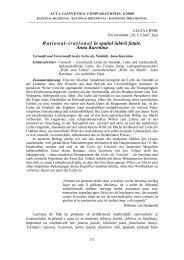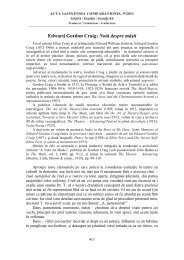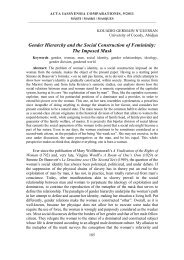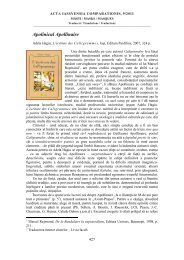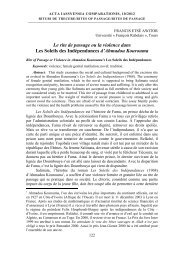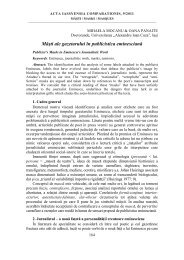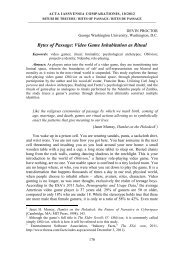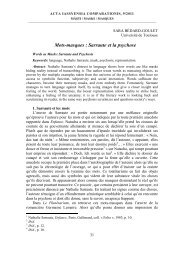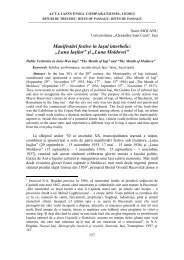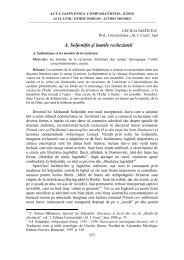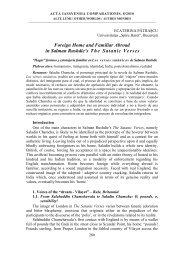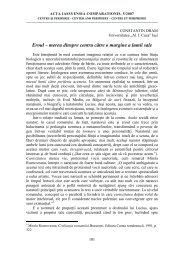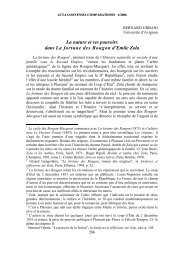Metamorphosis and Metadrama in A Midsummer Night's Dream
Metamorphosis and Metadrama in A Midsummer Night's Dream
Metamorphosis and Metadrama in A Midsummer Night's Dream
Create successful ePaper yourself
Turn your PDF publications into a flip-book with our unique Google optimized e-Paper software.
ACTA IASSYENSIA COMPARATIONIS, 6/2008<br />
RAŢIONAL-IRAŢIONAL / RATIONAL-IRRATIONAL / RATIONNEL-IRRATIONNEL<br />
________________________________________________________________________________<br />
CORNELIA MACSINIUC<br />
Universitatea „Ştefan cel Mare”, Suceava<br />
Paradoxes of Disbelief: <strong>Metamorphosis</strong> <strong>and</strong> <strong>Metadrama</strong><br />
<strong>in</strong> A M i d s u m m e r N i g h t ’ s D r e a m<br />
Paradoxes de l’<strong>in</strong>crédulité : métamorphose et métadrame dans L e s o n g e<br />
d ’ u n e n u i t d ’ é t é<br />
Mots clés : théâtre rationnel/irrationnel, contrat théâtral, métadrame comique, suspension<br />
de l’<strong>in</strong>crédulité, imag<strong>in</strong>ation, métamorphose, convention, dimension<br />
métagénérique<br />
Résumé :<br />
Partant de la prémisse que le « contrat théâtral » présuppose, de la part du spectateur<br />
aussi bien que de celle de l’acteur, une suspension volontaire de l’<strong>in</strong>croyance, cet article<br />
porte sur l’emploi du motif de la métamorphose dans Le songe d’une nuit d’été dans le<br />
contexte de la dimension métadramatique et métagénérique de la pièce. Focalisé sur<br />
l’épisode comique de la transposition théâtrale, par les artisans athéniens, de l’histoire de<br />
Pyramus et Thisbe, empruntée à Ovide, l’article explore la valeur métatropique de ce motif,<br />
qui figure le paradoxe de l’expérience théâtrale, déf<strong>in</strong>ie par la tension entre le détachement<br />
rationnel et l’ab<strong>and</strong>on à l’imag<strong>in</strong>ation, associée à l’irrationnel.<br />
In an article published <strong>in</strong> The Architectural Review, <strong>in</strong> 1995, Peter Blundell<br />
Jones cites architects Hans Scharoun <strong>and</strong> Margot Aschenbreuner, who make a<br />
dist<strong>in</strong>ction between rational <strong>and</strong> irrational theatre – not only from an architectural<br />
po<strong>in</strong>t of view (the rational, “perspective theatre” of the Renaissance <strong>and</strong> the<br />
Baroque was def<strong>in</strong>ed by its axis runn<strong>in</strong>g between the privileged seat of the ruler<br />
<strong>and</strong> the centre stage), but also from the po<strong>in</strong>t of view of thematic concerns.<br />
Accord<strong>in</strong>g to them, Shakespeare, along with Greek theatre <strong>and</strong> medieval mystery<br />
plays, illustrates irrational theatre because he “deal[s] with metaphysical themes,<br />
themes exceed<strong>in</strong>g a limited time <strong>and</strong> place” 1 . In “rational theatre” actors <strong>and</strong><br />
audience are “under the spell of the axis” 2 , <strong>and</strong> the clear separation of the stage<br />
from the audience emphasises the clear division between the play as a fictional<br />
construct <strong>and</strong> the real world.<br />
This division is most of the time accepted tacitly – it is part of the theatrical<br />
contract 3 whereby the audience, while <strong>in</strong> full knowledge of the untruth of what is<br />
presented on the stage, will<strong>in</strong>gly suspend disbelief, embrac<strong>in</strong>g the illusion.<br />
Voluntary self-delusion – to which, as Samuel Johnson was po<strong>in</strong>t<strong>in</strong>g out, there are<br />
“no certa<strong>in</strong> limitations” 4 – is the essence of theatrical enjoyment.<br />
1<br />
Peter Blundell Jones, “Irrational Theatre,” The Architectural Review, Vol. 197, February<br />
1995. Available at http://www.questia.com.<br />
2<br />
Ibid.<br />
3<br />
Cf. J. L. Styan, Perspectives on Shakespeare <strong>in</strong> Performance, New York: Peter Lang<br />
Publish<strong>in</strong>g, Inc., 2000, p. 111.<br />
4<br />
Cf. Samuel Johnson, Preface to Shakespeare’s Plays, 2001, Blackmask onl<strong>in</strong>e,<br />
http://www.blackmask.com .<br />
264
ACTA IASSYENSIA COMPARATIONIS, 6/2008<br />
RAŢIONAL-IRAŢIONAL / RATIONAL-IRRATIONAL / RATIONNEL-IRRATIONNEL<br />
________________________________________________________________________________<br />
Theatre actually deconstructs the very opposition between the rational <strong>and</strong> the<br />
irrational – to cite Dr. Johnson aga<strong>in</strong>, “the spectators are always <strong>in</strong> their senses, <strong>and</strong><br />
know, from the first act to the last, that the stage is only a stage, <strong>and</strong> that the<br />
players are only players” 5 . Donald Davidson po<strong>in</strong>ts to the paradoxical nature of this<br />
dichotomy, when he states that “the irrational is not merely the non-rational, which<br />
lies outside the ambit of the rational; irrationality is a failure with<strong>in</strong> the house of<br />
reason” 6 . With respect to the theatrical representation, this def<strong>in</strong>ition must be<br />
amended, or at least pondered on: is the suspension of rationality required from the<br />
audience a “failure,” or is it a capacity of a different nature, which Shakespeare<br />
himself calls “imag<strong>in</strong>ation”?<br />
In A <strong>Midsummer</strong> Night’s <strong>Dream</strong>, the device of the play-with<strong>in</strong>-the-play, used <strong>in</strong><br />
a comic key, gives a new twist to the paradox destabilis<strong>in</strong>g the opposition<br />
rationality–irrationality, <strong>in</strong> regard to both the actors <strong>and</strong> the audience. Theseus, who<br />
l<strong>in</strong>ks the faculty of the imag<strong>in</strong>ation – a faculty of the irrational m<strong>in</strong>d – with the<br />
evocative power of poetry, the <strong>in</strong>tensity of emotion, <strong>and</strong> the fool’s capacity for<br />
unreason, seems to draw a clear l<strong>in</strong>e between the realm of solid reality <strong>and</strong> the<br />
world of “shadows,” <strong>in</strong> which he <strong>in</strong>cludes theatrical representation. One of the<br />
paradoxes <strong>in</strong> the play is that such lucid metatheatrical <strong>in</strong>sights are offered at the end<br />
of a plot <strong>in</strong> which high fantasy has already carried the receptive audience far <strong>in</strong>to<br />
the world of make-believe. The representation that the Athenian artisans put on<br />
before Theseus <strong>and</strong> his company comically fails to seduce the audience <strong>in</strong> the play<br />
<strong>in</strong>to suspend<strong>in</strong>g disbelief, <strong>and</strong>, together with the scenes of its preparation,<br />
counterpo<strong>in</strong>t<strong>in</strong>g those of the romantic summer madness <strong>in</strong> the forest, it dramatizes<br />
the actual uncerta<strong>in</strong> divid<strong>in</strong>g l<strong>in</strong>e between rational detachment <strong>and</strong> imag<strong>in</strong>ative<br />
ab<strong>and</strong>onment that both watch<strong>in</strong>g a play <strong>and</strong> act<strong>in</strong>g <strong>in</strong> one presuppose.<br />
The metadramatic <strong>in</strong>sertions <strong>in</strong> A <strong>Midsummer</strong> Night’s <strong>Dream</strong> seem to be, by<br />
their comic nature, a lure back to rationality, but their greater effectiveness lies,<br />
arguably, <strong>in</strong> their power of suggest<strong>in</strong>g that theatre is always both rational <strong>and</strong><br />
irrational, that the audience is always <strong>in</strong>evitably caught <strong>and</strong> waver<strong>in</strong>g between the<br />
lucid conscience that the theatrical fabrication is “airy noth<strong>in</strong>g” <strong>and</strong> the mysterious<br />
pleasure of abdicat<strong>in</strong>g their rational watchfulness.<br />
This double b<strong>in</strong>d of the theatre audience is figured, <strong>in</strong> A <strong>Midsummer</strong> Night’s<br />
<strong>Dream</strong>, by the trope of metamorphosis 7 , which acquires a metadramatic significance<br />
5 Ibid.<br />
6 Donald Davidson, Problems of Rationality, Clarendon Press, 2004, p.169.<br />
7 Shakespeare’s most certa<strong>in</strong> source for his play was Ovid’s first translation <strong>in</strong>to English by<br />
Arthur Gold<strong>in</strong>g (1567), but he was surely aware of many other Renaissance translations <strong>and</strong><br />
adaptations, <strong>in</strong>clud<strong>in</strong>g a French version, Ovide moralisé (cf. David Garrison, Gongora <strong>and</strong><br />
the “Pyramus <strong>and</strong> Thisbe” Myth from Ovid to Shakespeare, Juan de la Cuesta, 1994, p.<br />
145), <strong>and</strong> it is supposed that he was acqua<strong>in</strong>ted with the Lat<strong>in</strong> orig<strong>in</strong>al as well. A<br />
<strong>Midsummer</strong> Night’s <strong>Dream</strong> borrows the story of Pyramus <strong>and</strong> Thisbe from Ovid, but this is<br />
only part of its <strong>in</strong>debtedness to the Roman poet. Jonathan Bate has described the play as<br />
“deeply but not directly Ovidian” (Shakespeare <strong>and</strong> Ovid, Clarendon Press, 1993, p. 131),<br />
exam<strong>in</strong><strong>in</strong>g the comic displacements which Ovid’s tale underwent <strong>in</strong> Shakespeare’s play, but<br />
emphasiz<strong>in</strong>g at the same time Shakespeare’s faithfulness to the spirit of Ovid’s work: “It is<br />
265
ACTA IASSYENSIA COMPARATIONIS, 6/2008<br />
RAŢIONAL-IRAŢIONAL / RATIONAL-IRRATIONAL / RATIONNEL-IRRATIONNEL<br />
________________________________________________________________________________<br />
<strong>and</strong> bears on the metageneric dimension of the play. The experience of metamorphosis<br />
presupposes, like theatrical experience, a certa<strong>in</strong> stra<strong>in</strong> on rationality, s<strong>in</strong>ce one has to<br />
admit the quasi-impossibility that someth<strong>in</strong>g belongs simultaneously to two<br />
<strong>in</strong>compatible orders of be<strong>in</strong>g or reality, between which there is a mysterious exchange.<br />
In the middle of the play, Puck’s wicked prank of bestow<strong>in</strong>g an ass’s head on<br />
Bottom the weaver creates astonishment <strong>and</strong> comic fear among the latter’s fellows –<br />
most notably, Peter Qu<strong>in</strong>ce’s exclamation “Bless thee, Bottom! bless thee! Thou art<br />
translated” modulates the grotesque comedy of the Athenian craftsman’s<br />
scapegoat<strong>in</strong>g with the almost mystical suggestion of his “transportation” to another<br />
realm (<strong>in</strong> IV, 2. 4, Starvel<strong>in</strong>g accounts for Bottom’s absence: “He is transported”) 8 .<br />
Translated is a key word <strong>in</strong> Shakespeare’s play. Used only three times, out of<br />
which two <strong>in</strong> connection with Bottom’s metamorphosis, it carries nevertheless a host<br />
of implications, related not only to the thematic issue of the work<strong>in</strong>gs of “strong<br />
imag<strong>in</strong>ation” (cf. V, 1. 18), or to the plot contrivance of the exchanges between the<br />
fantasy world of the fairies <strong>and</strong> the Athenian “reality, 9 but also to the metageneric<br />
issues that the play raises <strong>and</strong> to the complex metadramatic uses to which its ma<strong>in</strong><br />
source, Ovid’s Metamorphoses, is put.<br />
“Translation,” <strong>in</strong> Jonathan Bate’s argument, is explicitly an equivalent for<br />
“displacement,” which is <strong>in</strong>deed the dom<strong>in</strong>ant trope <strong>in</strong> a play deal<strong>in</strong>g with the<br />
unfixedness of human emotions <strong>and</strong> the unreliability of human perceptions – with the<br />
more general theme of the transfigur<strong>in</strong>g powers of love <strong>and</strong> imag<strong>in</strong>ation – both of<br />
them seen as manifestations of the irrational m<strong>in</strong>d. Displacement – an essential<br />
aspect of the dream work – resolves, <strong>in</strong> Shakespeare’s <strong>Dream</strong>, the conflicts <strong>and</strong><br />
contradictions of the day by immers<strong>in</strong>g the protagonists <strong>in</strong> strange nocturnal<br />
experiences, <strong>in</strong>volv<strong>in</strong>g the metamorphosis of desire. When the light of day (the return<br />
to rationality) rescues the characters from the <strong>in</strong>comprehensible, the erratic, the<br />
accidental, <strong>and</strong> the arbitrary, the young characters are f<strong>in</strong>ally “translated” <strong>in</strong>to the<br />
appropriate relationship, <strong>and</strong> Desire <strong>and</strong> Law are reconciled <strong>in</strong> marriage.<br />
The cluster of issues that may be associated with translation – displacement (<strong>and</strong><br />
condensation, if we stay with<strong>in</strong> the Freudian frame of reference), transposition,<br />
transportation, transfiguration, dis-figuration, metamorphosis – is particularly<br />
prom<strong>in</strong>ent <strong>in</strong> the str<strong>and</strong> of plot regard<strong>in</strong>g the Athenian craftsmen <strong>and</strong> their stag<strong>in</strong>g<br />
<strong>and</strong> performance of Pyramus <strong>and</strong> Thisbe. Their “translation” of Ovid’s tale <strong>in</strong>to<br />
theatrical representation raises not simply the issues of fidelity <strong>and</strong> orig<strong>in</strong>ality, but<br />
elsewhere <strong>in</strong> the play, not <strong>in</strong> ‘Pyramus <strong>and</strong> Thisbe,’ that we f<strong>in</strong>d all the marks of true<br />
Ovidianism: a philosophy of love <strong>and</strong> change, the operation of the gods, animal<br />
transformation, <strong>and</strong> symbolic vegetation. It is the translation of these elements out of the<br />
play with<strong>in</strong> <strong>and</strong> <strong>in</strong>to the play itself that transforms A <strong>Midsummer</strong> Night’s <strong>Dream</strong> <strong>in</strong>to the<br />
most lum<strong>in</strong>ous imitation of Ovid” (ibid., p. 132).<br />
8 All the references to Shakespeare’s text will be made to the follow<strong>in</strong>g edition: The<br />
Complete Works of William Shakespeare, edited, with a Glossary by W. J. Craig, London:<br />
Henry Pordes, 1984.<br />
9 The first occurrence of “translated”, <strong>in</strong> one of Helena’s l<strong>in</strong>es, carries the implication of<br />
“exchange”: “Were the world m<strong>in</strong>e, Demetrius be<strong>in</strong>g bated, / The rest I’d give to you to be<br />
translated” (I, 1. 190-1).<br />
266
ACTA IASSYENSIA COMPARATIONIS, 6/2008<br />
RAŢIONAL-IRAŢIONAL / RATIONAL-IRRATIONAL / RATIONNEL-IRRATIONNEL<br />
________________________________________________________________________________<br />
also those of the relationship between the actor <strong>and</strong> his part, <strong>and</strong> of the “translation”<br />
of the audience. In the metadramatic device of the play-with<strong>in</strong>-the-play, the positions<br />
of actors, characters, <strong>and</strong> spectators become highly unstable, as the boundaries between<br />
them are shift<strong>in</strong>g or erased. This displacement <strong>and</strong> condensation of roles, to which<br />
the <strong>Dream</strong>’s Pyramus <strong>and</strong> Thisbe draws attention, endorses a central idea <strong>in</strong><br />
Shakespeare’s play: that of the metamorphic logic of the imag<strong>in</strong>ation.<br />
Love has the same metamorphic capacity, as Helena’s meditation shows:<br />
“Th<strong>in</strong>gs base <strong>and</strong> vile, hold<strong>in</strong>g no quantity, / Love can transpose to form <strong>and</strong> dignity”<br />
(I, 1. 232-3). The comic counterpart of this romantic theme is dramatized <strong>in</strong> Titania’s<br />
<strong>in</strong>fatuation with “a monster” – the “translation” of Bottom <strong>in</strong>to Titania’s ass-headed<br />
lover be<strong>in</strong>g Shakespeare’s displaced version of Ovidian metamorphosis. In this<br />
episode, the two themes – love <strong>and</strong> imag<strong>in</strong>ation – are brought together to be given a<br />
comic, even grotesque, twist. The magic potion that Puck places on the eyelids of<br />
Titania <strong>and</strong> the other characters – the displaced equivalent of Cupid’s arrows – has<br />
actually the symbolic role of activat<strong>in</strong>g the imag<strong>in</strong>ation <strong>and</strong> its transfigur<strong>in</strong>g power,<br />
just as the theatrical representation does, when it requires the audience to suspend<br />
their disbelief about the “shadows,” the th<strong>in</strong>gs with “no quantity,” the “airy<br />
noth<strong>in</strong>g” that “beguiles” the spectator’s eye. As <strong>in</strong> love, which “looks not with the<br />
eyes, but with the m<strong>in</strong>d”, as Helena puts it (I, 1. 234), a certa<strong>in</strong> “bl<strong>in</strong>dness” – a<br />
postponement of rational judgement – is required from the imag<strong>in</strong>ative spectator of<br />
a theatrical representation, who should be will<strong>in</strong>g to forget that “the best <strong>in</strong> this<br />
k<strong>in</strong>d are but shadows”, as Theseus reassures Hippolyta (V, 1. 217).<br />
Ovid’s tale of Pyramus <strong>and</strong> Thisbe undergoes a double metamorphosis <strong>in</strong> A<br />
<strong>Midsummer</strong> Night’s <strong>Dream</strong>. On a first level it is “translated,” <strong>in</strong> comic-romantic<br />
key, <strong>in</strong>to the story of Hermia <strong>and</strong> Lys<strong>and</strong>er <strong>and</strong> their threatened love, thwarted by<br />
parental authority. At the h<strong>and</strong>s of the Athenian craftsmen, it turns <strong>in</strong>to burlesque,<br />
but develops metadramatic levels which constitute implicit comments on the limits<br />
<strong>and</strong> possibilities of theatrical art. For the simple artisans, the attempt to convert one<br />
k<strong>in</strong>d of discourse <strong>in</strong>to another (narrative <strong>in</strong>to dramatic) poses more problems than<br />
they can be aware of, yet their delightfully comic unself-consciousness creates a<br />
context for reflection on the work<strong>in</strong>gs of dramatic imag<strong>in</strong>ation.<br />
At once bound by <strong>in</strong>herent theatrical convention – reason’s roundabout way of<br />
deal<strong>in</strong>g with the untruth of the world on the stage – <strong>and</strong> aim<strong>in</strong>g at exact<br />
representation, the artisans wonder, for <strong>in</strong>stance, how they are to solve the problem<br />
of “moonsh<strong>in</strong>e” <strong>and</strong> “wall,” two “hard th<strong>in</strong>gs” for Qu<strong>in</strong>ce (cf. II, 2. 52), which<br />
require dramatic “translation.” They are tempted by the realistic, literalistic extreme<br />
of br<strong>in</strong>g<strong>in</strong>g the objects themselves on stage (Bottom is eager to f<strong>in</strong>d a calendar, to<br />
“f<strong>in</strong>d out moonsh<strong>in</strong>e” <strong>and</strong> suggests leav<strong>in</strong>g open the casement of the w<strong>in</strong>dow so the<br />
moon may sh<strong>in</strong>e <strong>in</strong> dur<strong>in</strong>g their performance). Qu<strong>in</strong>ce, more aware of the<br />
limitations of dramatic representation, pushes conventionalism to the extreme,<br />
suggest<strong>in</strong>g that moonsh<strong>in</strong>e be embodied by an actor: “Ay, or else one must come <strong>in</strong><br />
with a bush of thorns <strong>and</strong> a lanthorn, <strong>and</strong> say he comes to disfigure, or to present,<br />
the person of Moonsh<strong>in</strong>e” (II, 2. 69). Bottom, newly awakened to the range of<br />
choices that the theatrical trade offered, promptly suggests a similar solution to the<br />
problem of the wall: “Some man or other must present Wall; <strong>and</strong> let him have some<br />
267
ACTA IASSYENSIA COMPARATIONIS, 6/2008<br />
RAŢIONAL-IRAŢIONAL / RATIONAL-IRRATIONAL / RATIONNEL-IRRATIONNEL<br />
________________________________________________________________________________<br />
plaster, or some loam, or some rough-cast about him, to signify Wall; <strong>and</strong> let him<br />
hold his f<strong>in</strong>gers thus, <strong>and</strong> through that cranny shall Pyramus <strong>and</strong> Thisbe whisper”<br />
(II, 2. 76). In the context of the larger issue of metamorphosis as the “translation”<br />
of the actor <strong>in</strong>to his role, this episode derives its comedy from the idea of the<br />
demotion of the human to the status of dramatic signifier for an object 10 , <strong>and</strong> of the<br />
object raised to the dignity of “person” – a possible displaced allusion to the traditional<br />
metamorphic exchange between the realms of the human <strong>and</strong> non-human.<br />
The issue of irrationality looms aga<strong>in</strong> here, s<strong>in</strong>ce act<strong>in</strong>g requires, <strong>in</strong> its turn, the<br />
suspension of the rational self which we take as the ground for one’s identity.<br />
American drama critic John Lahr, for <strong>in</strong>stance, considered that “[p]erform<strong>in</strong>g is a<br />
k<strong>in</strong>d of ecstasy, an act so <strong>in</strong>spired <strong>and</strong> irrational that – at its extremes, it can seem<br />
vulgar, lunatic <strong>and</strong> dangerous” 11 . Snout’s “metamorphosis” <strong>in</strong>to “Wall” is an<br />
extreme example of the irrationality of role-play<strong>in</strong>g.<br />
The very idea of metamorphosis, central to Ovid’s work, is most successfully<br />
displaced <strong>in</strong> this metadramatic frame. This metamorphosis at the second power – a<br />
craftsman turned actor turned Wall/Moonsh<strong>in</strong>e/lion is literally a dis-figuration.<br />
Bottom’s directions for Snug, who will “play” the lion, h<strong>in</strong>t at this destruction of the<br />
figure that metamorphosis entails: “you must name his name, <strong>and</strong> half his face must<br />
be seen through the lion’s neck; <strong>and</strong> he himself must speak through” (II. 2. 48). The<br />
actor com<strong>in</strong>g forth <strong>and</strong> “present<strong>in</strong>g” Wall, but also <strong>in</strong>sist<strong>in</strong>g on his real identity, does<br />
<strong>in</strong>deed “disfigure” Wall, <strong>in</strong> the sense that he thus destroys the metaphor which b<strong>in</strong>ds<br />
him to his role. Perform<strong>in</strong>g a role may be assimilated, like metamorphosis, to the<br />
metaphoric order of discourse: it amounts, as metaphor does, to “feign<strong>in</strong>g to describe<br />
someth<strong>in</strong>g else while also describ<strong>in</strong>g the sameness of the changed self” 12 . However,<br />
<strong>in</strong> the process, the figure is destroyed, s<strong>in</strong>ce, while metaphoric relationship is one of<br />
simultaneity, therefore exclud<strong>in</strong>g time, metamorphosis presupposes “time, process<br />
<strong>and</strong> displacement,” a before <strong>and</strong> an after. As Michel Le Guern argues,<br />
“metamorphosis takes place only because there is no more metaphor… The metaphor<br />
gives the poet the idea of metamorphosis, but the poetic illusion can only be<br />
produced through the figure’s destruction” 13 . Qu<strong>in</strong>ce’s solecism, offer<strong>in</strong>g “disfigure”<br />
as an alternative to “present,” conveys a paradoxical unwitt<strong>in</strong>g wisdom about<br />
metamorphosis as a trope for act<strong>in</strong>g <strong>and</strong> about the necessary play with the dist<strong>in</strong>ction<br />
between the literal <strong>and</strong> the figurative that it <strong>in</strong>volves 14 .<br />
10<br />
For Bergson, the essence of risibility consists <strong>in</strong> the rigidity of the object tak<strong>in</strong>g over the<br />
human. An actor embody<strong>in</strong>g a wall represents a “momentary transfiguration of a person <strong>in</strong>to an<br />
object” – a classic source of laughter (cf. Teoria rîsului, Iaşi: Institutul European, 1991, p. 54).<br />
11<br />
Quoted <strong>in</strong> J. L. Styan, “The Drama: Reason <strong>in</strong> Madness,” Theatre Journal, vol. 31, no. 3,<br />
Oct. 1980, p. 371.<br />
12<br />
Kai Mikkonen, “Theories of metamorphosis: from metatrope to textual revision,” Style,<br />
6/22/1996, cit<strong>in</strong>g Pierre Brunel. Available at http://www.highbeam.com/doc/1G1-19175945.html.<br />
13<br />
Quoted <strong>in</strong> Mikkonen, op. cit.<br />
14<br />
Cf. Mikkonen, op. cit. A further play on this dist<strong>in</strong>ction, <strong>and</strong> another <strong>in</strong>stance of<br />
metamorphosis as the destruction of metaphor, is illustrated <strong>in</strong> Bottom’s partial<br />
transformation <strong>in</strong>to an ass.<br />
268
ACTA IASSYENSIA COMPARATIONIS, 6/2008<br />
RAŢIONAL-IRAŢIONAL / RATIONAL-IRRATIONAL / RATIONNEL-IRRATIONNEL<br />
________________________________________________________________________________<br />
It is not, as Jonathan Bate argues, the “obsessive literalism” of the craftsmen<br />
that makes the play a risibly “deficient translation” 15 ; the metamorphosis of a tragic<br />
tale <strong>in</strong>to grotesque comedy <strong>in</strong> A <strong>Midsummer</strong> Night’s <strong>Dream</strong> is rather the effect of<br />
the players’ <strong>in</strong>decision about which strategies of representation are more<br />
appropriate to their purpose.<br />
There is, on the one h<strong>and</strong>, the issue of total identification, the elim<strong>in</strong>ation of the<br />
conventional distance between actor <strong>and</strong> character, as when Bottom is persuaded<br />
by Qu<strong>in</strong>ce that there is a necessary connection between him <strong>and</strong> the role of<br />
Pyramus: “You can play no part but Pyramus; for Pyramus is a sweet-faced man; a<br />
proper man, as one shall see <strong>in</strong> a summer’s day; a most lovely, gentleman-like man;<br />
therefore you must needs play Pyramus” (II, 1. 92). 16 In this case, the relationship<br />
actor-character emphasises similarity <strong>and</strong> substitution, which are def<strong>in</strong><strong>in</strong>g for<br />
metaphor as a trope. On the other h<strong>and</strong>, Bottom’s <strong>in</strong>sistence on keep<strong>in</strong>g the<br />
audience aware of the distance between actor <strong>and</strong> part, his suggestion that a<br />
prologue should exhibit this difference <strong>and</strong> tell them that the lion “is not a lion”<br />
makes role-play<strong>in</strong>g <strong>in</strong>cl<strong>in</strong>e more towards the trope of metonymy (etymologically, a<br />
change of name: meta+onoma). He even conceives the script for Snug’s disclaimer<br />
to the audience: “«If you th<strong>in</strong>k I come hither as a lion, it were pity of my life: no, I<br />
am no such th<strong>in</strong>g: I am a man as other men are», <strong>and</strong> there <strong>in</strong>deed let him name his<br />
name, <strong>and</strong> tell them pla<strong>in</strong>ly he is Snug the jo<strong>in</strong>er” (III, 1. 44-48).<br />
This hover<strong>in</strong>g between extreme approaches to the actor’s art suggests that<br />
metamorphosis as the actor’s “translation” <strong>in</strong>to a role – <strong>and</strong> more generally as “the<br />
specific function of the imag<strong>in</strong>ation <strong>in</strong> the comprehension <strong>and</strong> production of<br />
forms” 17 – occupies <strong>in</strong>deed an unsettled middle ground between metaphor <strong>and</strong><br />
metonymy. Kai Mikkonen cites Bachelard’s def<strong>in</strong>ition of metamorphosis as a<br />
metatrope, “a trope that st<strong>and</strong>s for trop<strong>in</strong>g <strong>and</strong> imag<strong>in</strong>ation” 18 , which is particularly<br />
applicable to its status of metadramatic device <strong>in</strong> A <strong>Midsummer</strong> Night’s <strong>Dream</strong>.<br />
The actual metamorphosis of Bottom <strong>in</strong>to a monstrous ass-headed creature may<br />
ultimately be <strong>in</strong>terpreted <strong>in</strong> the light of the play’s metadramatic strategies. It is<br />
<strong>in</strong>terest<strong>in</strong>g that Bottom appears <strong>in</strong>itially as the supercompetent actor, feel<strong>in</strong>g<br />
equally capable of mov<strong>in</strong>g the audience to tears as Pyramus (“I will move storms”),<br />
of speak<strong>in</strong>g “<strong>in</strong> a monstrous little voice” as Thisbe, as well as roar<strong>in</strong>g, if necessary,<br />
“as gentle as any suck<strong>in</strong>g dove,” “as ‘twere a night<strong>in</strong>gale” <strong>in</strong> the role of the lion. Of<br />
all the would-be actors, Bottom, <strong>in</strong> the enthusiasm of his self-discovery as a multi-<br />
15 J. Bate, op. cit., pp. 131-2.<br />
16 In the immediate context, it may seem as if Qu<strong>in</strong>ce’s argument is only a sweeten<strong>in</strong>g<br />
technique, meant to quell Bottom’s frustration at not be<strong>in</strong>g able to play all the roles; later,<br />
however, when Bottom disappears on them, be<strong>in</strong>g “transported” to Titania’s “flowery bed,”<br />
they seem conv<strong>in</strong>ced of Bottom’s irreplaceability:<br />
“Flute: If he come not then the play is marred: it goes not forward, doth it?<br />
Qu<strong>in</strong>ce: It is not possible: you have not a man <strong>in</strong> all Athens able to discharge Pyramus but he”<br />
(V, 1. 5-9).<br />
17 K. Mikkonen, op. cit.<br />
18 Ibid.<br />
269
ACTA IASSYENSIA COMPARATIONIS, 6/2008<br />
RAŢIONAL-IRAŢIONAL / RATIONAL-IRRATIONAL / RATIONNEL-IRRATIONNEL<br />
________________________________________________________________________________<br />
valent actor, seems to have no problems with metamorphos<strong>in</strong>g himself for any role.<br />
It is this extreme availability for metamorphic experience – comically suggested by<br />
his absurd eagerness to play all the roles at once – that qualifies him for the “real”<br />
metamorphosis. Bottom’s <strong>in</strong>volvement with the dramatic art goes so far as<br />
frequently tak<strong>in</strong>g over the role of director – his ignorance of the orig<strong>in</strong>al story does<br />
not prevent him from offer<strong>in</strong>g “creative” solutions (often “mistranslations”) <strong>in</strong> its<br />
stag<strong>in</strong>g. It is part of the structure of irony <strong>in</strong> the play that Bottom will be arbitrarily<br />
cast <strong>in</strong> a role <strong>in</strong> whose script<strong>in</strong>g he could have no h<strong>and</strong> <strong>and</strong> which he will play with<br />
complete unself-consciousness. Half-turned <strong>in</strong>to an ass without be<strong>in</strong>g aware of it,<br />
he cont<strong>in</strong>ues to apply the word “ass” to himself figuratively <strong>and</strong> jok<strong>in</strong>gly, without<br />
realis<strong>in</strong>g that the metaphor has been destroyed by literalisation (“meth<strong>in</strong>ks I am<br />
marvellous hairy about the face; <strong>and</strong> I am such a tender ass, as if my hair do but<br />
tickle me, I must scratch” – IV, 1. 27-29). In his complete assumption of his new<br />
condition, he naturally settles for “a peck of provender,” “good dry oats” <strong>and</strong> “a<br />
bottle of hay” (IV, 1. 35-37) when Titania asks her “sweet love” what he desires to<br />
eat. The grotesque comedy of Bottom’s “translation” has serious metadramatic<br />
implications concern<strong>in</strong>g the successful discharg<strong>in</strong>g of roles <strong>and</strong> the changes <strong>in</strong><br />
one’s sense of identity that it <strong>in</strong>volves.<br />
<strong>Metamorphosis</strong> <strong>in</strong> Shakespeare’s play is def<strong>in</strong>itely a metatrope for the structural<br />
convention of confusion <strong>in</strong> the comic plot, but as such it functions also<br />
metagenerically, po<strong>in</strong>t<strong>in</strong>g to the confusion <strong>and</strong> mixture of different k<strong>in</strong>ds of drama.<br />
The lay<strong>in</strong>g bare of the pr<strong>in</strong>ciples of theatrical performance <strong>and</strong> role-act<strong>in</strong>g, <strong>in</strong> the<br />
“rude mechanicals”’ stag<strong>in</strong>g of Ovid’s tale of Pyramus <strong>and</strong> Thisbe, effects the<br />
complete metamorphosis of a tragic story <strong>in</strong>to a burlesque comedy. Shakespeare was<br />
notoriously fasc<strong>in</strong>ated with the possibility of mix<strong>in</strong>g or transform<strong>in</strong>g generic<br />
conventions, his work display<strong>in</strong>g <strong>in</strong> a unique way the decision to ignore the<br />
Aristotelian segregation between tragedy <strong>and</strong> comedy. Critics have been po<strong>in</strong>t<strong>in</strong>g out<br />
the difficulty of classify<strong>in</strong>g Shakespeare’s plays at least s<strong>in</strong>ce Samuel Johnson, who<br />
remarked <strong>in</strong> his Preface to the 1765 edition: “Shakespeare’s plays are not <strong>in</strong> the<br />
rigorous or critical sense either tragedies or comedies, but compositions of a dist<strong>in</strong>ct<br />
k<strong>in</strong>d (…)” 19 . In A <strong>Midsummer</strong> Night’s <strong>Dream</strong>, it is Theseus that h<strong>in</strong>ts at the pleasure<br />
to be derived from generic confusion: when Hippolyta expresses her apprehensions at<br />
the player’s <strong>in</strong>competence (“He [i.e. Philostratus] says they can do noth<strong>in</strong>g <strong>in</strong> this<br />
k<strong>in</strong>d [i.e. tragedy]”), he replies: “Our sport shall be to take what they mistake (V, 1.<br />
88; 90). He thus excuses <strong>in</strong> advance the apparent <strong>in</strong>congruity <strong>in</strong> the title of the<br />
craftsmen’s play: A tedious brief scene of young Pyramus / And his love Thisbe; very<br />
tragical mirth,” mould<strong>in</strong>g thereby the audience’s attitude <strong>in</strong>to one of joyous<br />
receptiveness, by propos<strong>in</strong>g to “f<strong>in</strong>d the concord <strong>in</strong> this discord” (V, 1. 60).<br />
The metamorphosis of a tragic tale <strong>in</strong>to comic metadrama creates a subtle myseen-abyme<br />
for the play’s ma<strong>in</strong> conflict, with its confusions <strong>and</strong> mistakes, <strong>and</strong>, above<br />
all, with its potentially tragic end<strong>in</strong>g, adumbrated by Egeus’s early <strong>in</strong>vocation of<br />
Athenian law, accord<strong>in</strong>g to which Hermia may <strong>in</strong>cur death punishment for her<br />
disobedience (cf. I, 1. 42-44). Lys<strong>and</strong>er might even have had <strong>in</strong> m<strong>in</strong>d Ovid’s tale <strong>and</strong><br />
19 Samuel Johnson, op.cit.<br />
270
ACTA IASSYENSIA COMPARATIONIS, 6/2008<br />
RAŢIONAL-IRAŢIONAL / RATIONAL-IRRATIONAL / RATIONNEL-IRRATIONNEL<br />
________________________________________________________________________________<br />
its tragic outcome when he says: “for aught that I could read, / Could ever hear by<br />
tale or history, /The course of true love never did run smooth” (I, 1. 132-4). It might<br />
seem curious, therefore, that the four lovers should not recognize a possible version<br />
of their own predicament <strong>in</strong> the story of Pyramus <strong>and</strong> Thisbe.<br />
This detachment <strong>and</strong> “un-recognition” may be accounted for, on the one h<strong>and</strong>,<br />
by the “dream” quality of the confusions of the previous night, as Demetrius’s<br />
reference to those events also suggests: “These th<strong>in</strong>gs seem small <strong>and</strong><br />
undist<strong>in</strong>guishable, / Like far-off mounta<strong>in</strong>s turned <strong>in</strong>to clouds” (IV, 1. 193-4).<br />
Their present light-heartedness is founded on forgetfulness: not be<strong>in</strong>g able to fully<br />
br<strong>in</strong>g to consciousness the strange experiences they have been go<strong>in</strong>g through is a<br />
proof of the effectiveness of the metamorphic power of whatever <strong>in</strong> the play counts<br />
as “dream” 20 .<br />
On the other h<strong>and</strong>, their apparent bl<strong>in</strong>dness to the possibility of compar<strong>in</strong>g their<br />
ordeal with that of the Babylonian lovers may be expla<strong>in</strong>ed by the dramatic<br />
distance imposed by the carnivalesque “translation” of Ovid’s tragic tale <strong>in</strong>to a<br />
“palpable-gross play,” as Theseus describes it (V, 2. 376). The would-be actors step<br />
out of their roles apologetically, to reassure the audience about their “real”<br />
identities, while the metadramatised audience – the actor-characters become<br />
spectators – <strong>in</strong>sert their own comments <strong>in</strong> the script, exchange replies with the<br />
performers, <strong>and</strong> even assume a directorial stance (as when Lys<strong>and</strong>er gives a mock<br />
<strong>in</strong>dication to one of the players: “Proceed, Moon” – V. 1. 262).<br />
This metadramatic carnivalisation – <strong>in</strong> essence a metamorphic technique –<br />
whereby the low-born players <strong>and</strong> the elite audience are drawn together <strong>in</strong>to a<br />
theatrical impromptu <strong>in</strong> which frames are transgressed, positions are shifted, <strong>and</strong><br />
the mimetic illusion is completely destroyed, produces generic ambivalence, <strong>and</strong><br />
the confusion of positions <strong>and</strong> distances that it presupposes prevents the audience<br />
<strong>in</strong> the play from achiev<strong>in</strong>g suspension of disbelief, <strong>and</strong> thus from experienc<strong>in</strong>g<br />
tragic katharsis, whose precondition would have been the empathic identification<br />
ensured by successful mimesis.<br />
Comedy has always claimed alliance with reason, <strong>and</strong> to some extent any<br />
metadramatic (or metafictional) strategy partakes of the comic, as it presupposes a<br />
distraction (<strong>in</strong> the sense used by Bergson) from content or substance to the<br />
work<strong>in</strong>gs of form – an <strong>in</strong>stance, ultimately, of what Bergson saw as “the letter of<br />
the text try<strong>in</strong>g to tease the spirit of the text” 21 . Through the artisans <strong>in</strong> A<br />
<strong>Midsummer</strong> Night’s <strong>Dream</strong>, Shakespeare shows that the dramatist must be<br />
20 Bottom, whose half-metamorphosis <strong>in</strong>to an ass is accompanied by an unexpected,<br />
paradoxical display of wisdom, knows too well what Freud was to formulate three centuries<br />
later: the most effective dreams are <strong>in</strong>deed those which defy articulation upon awaken<strong>in</strong>g<br />
(cf. Sigmund Freud, Interpretarea viselor, traducere de Leonard Gavriliu, Editura<br />
Şti<strong>in</strong>ţifică, Bucureşti, 1993, p. 474). His contentment rests on the acceptance of his<br />
<strong>in</strong>capacity of translat<strong>in</strong>g the dream <strong>in</strong>to words: “I have had a most rare vision. I have had a<br />
dream, past the wit of man to say what dream it was: man is but an ass, if he go about<br />
expound<strong>in</strong>g his dream” (V, 1. 210-14).<br />
21 Op. cit., p. 52 (transl. m<strong>in</strong>e).<br />
271
ACTA IASSYENSIA COMPARATIONIS, 6/2008<br />
RAŢIONAL-IRAŢIONAL / RATIONAL-IRRATIONAL / RATIONNEL-IRRATIONNEL<br />
________________________________________________________________________________<br />
confident that the spectators “are always <strong>in</strong> their senses.” Over-concern with the<br />
mechanics of the performance <strong>and</strong> with “realism” (therefore with the rational), <strong>and</strong><br />
the excessive effort to control audience reaction represent attempts to re-write the<br />
terms of the “theatrical contract.” The comic determ<strong>in</strong>ation with which they<br />
proceed to elim<strong>in</strong>ate the irrational component from the audience’s response might<br />
entitle one to remark, <strong>in</strong>vert<strong>in</strong>g the words of Polonius: “there is madness <strong>in</strong> their<br />
method.”<br />
BIBLIOGRAPHY<br />
The Complete Works of William Shakespeare, edited, with a Glossary by W. J. Craig,<br />
London: Henry Pordes, 1984.<br />
Bate, Jonathan, Shakespeare <strong>and</strong> Ovid, Clarendon Press, 1993<br />
Bergson, Henri, Teoria râsului, Institutul European, Iaşi, 1992<br />
Blundell Jones, Peter, “Irrational Theatre,” The Architectural Review, Vol. 197, February<br />
1995. Available at http://www.questia.com<br />
Davidson, Donald, Problems of Rationality, Clarendon Press, 2004<br />
Freud, Sigmund, Interpretarea viselor, traducere, preambul la versiunea în limba română şi<br />
note de dr. Leonard Gavriliu, Editura Şti<strong>in</strong>ţifică, Bucureşti, 1993<br />
Garrison, David, Gongora <strong>and</strong> the “Pyramus <strong>and</strong> Thisbe Myth from Ovid to Shakespeare,<br />
Juan de la Cuesta, 1994<br />
Johnson, Samuel, Preface to Shakespeare’s Plays, 2001, Blackmask onl<strong>in</strong>e, available at<br />
http://www.blackmask.com.<br />
Mikkonen, Kai, “Theories of metamorphosis: from metatrope to textual revision,” Style,<br />
6/22/1996. Available at http://www.highbeam.com/doc/1G1-19175945.html.<br />
J. L. Styan, “The Drama: Reason <strong>in</strong> Madness,” Theatre Journal, vol. 31, no. 3, Oct. 1980<br />
(pp. 371-383)<br />
J. L. Styan, Perspectives on Shakespeare <strong>in</strong> Performance, New York: Peter Lang<br />
Publish<strong>in</strong>g, Inc., 2000<br />
272




